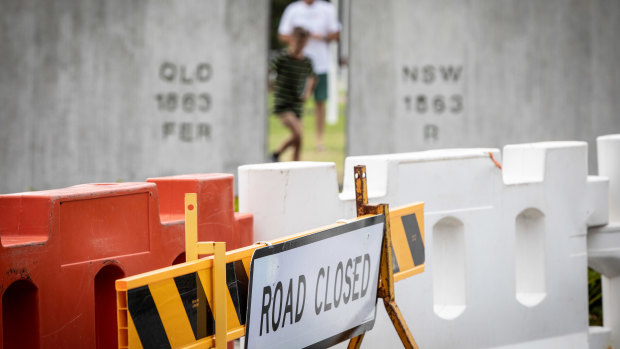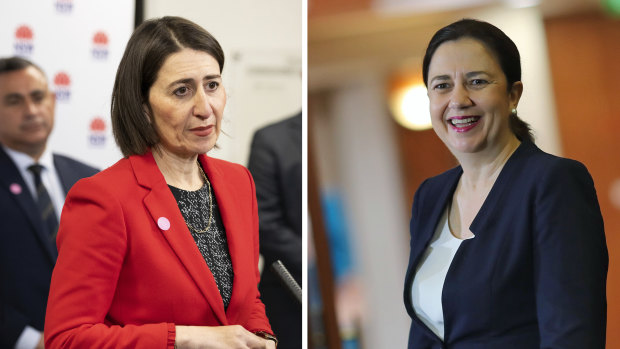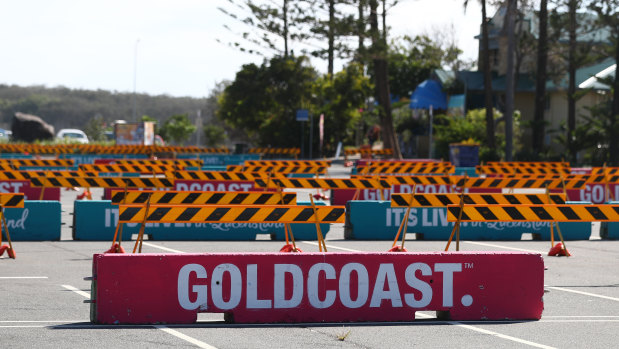This was published 4 years ago
After 250 days, Queensland's border wall is coming down
By Lydia Lynch
Whoops, I am in New South Wales.
The realisation hit about five minutes to midnight on March 25. Queensland was closing its borders to NSW for the first time in 100 years and I was in the wrong state.

Queensland is currently closed to Sydney residents and Victorians. Credit: Paul Harris
No hard blockades had been erected along the southern Gold Coast the night the border closed, just rows of orange traffic cones accompanied by police checks, similar to an RBT.
I zipped back across the border without trouble, just in time to join a pack of sleepy-eyed journalists gathered at an M1 off-ramp waiting to hear from Gold Coast police boss, Mark Wheeler.
The chief superintendent warned the borders would be closed "for months, not weeks" to halt the spread of COVID-19, a decision announced by Annastaica Palaszczuk on Twitter a few days earlier.
What turned into months of escalating tension between Ms Palaszczuk and her NSW counterpart, Gladys Berejiklian, began as an uncontroversial decision based on health advice.
Queensland's border restrictions followed those implemented by South Australia, Western Australia, Tasmania and the Northern Territory.
A few weeks into the border closures, police realised the traffic cones and plastic blockades would not be enough to stop people coming into Queensland (or accidently crossing into NSW).
Hundreds of metres of heavy concrete blocks were fork-lifted along the border to create "significant infastructure" that will begin to be pulled apart this week.
Despite the concrete wall surrounding Queensland, police still caught people hiding in the back of boots and trucks, trying to sneak across the border.
It was the time of the pandemic when the Gold Coast was a hotspot for cases, ICUs were braced to ventilate enough people to fill Suncorp Stadium, Queenslanders risked a $1300 fine if visitors were caught in their home and people could only go out for food, medicine or work.

Gladys Berejiklian and Annastacia Palaszczuk's border stoush has been ongoing for most of 2020. Credit: Renee Nowytarger
Just hours before the borders were slammed shut, health officials had confirmed Australia's ninth COVID-19 death.
Toowoomba man Garry Kirstenfeldt, 68, died alone in intensive care after he was infected with COVID-19 on board a Royal Caribbean cruise ship that docked in Sydney.
Mr Kirstenfeldt's wife and two of his four children were unable to attend the funeral, because of pandemic restrictions.
A total of 907 Australians have now died from COVID-19, most of those were Victorians. All of the six Queenslanders who died from the virus caught it overseas.

Barricades set up at the Spit. Credit: Getty
Ms Palaszczuk believes the state's border closures saved the lives of hundreds of Queenslanders, while others criticised inconsistency around decision making.
Anguished families were stranded in COVID-free states and quarantine after being denied exemptions to attend funerals while patients returning home from surgery were forced to recover from hotel rooms.
The border closures divided families but united the Queensland electorate behind the Premier, delivering her a 52-seat majority at the October 31 election.
Tuesday will mark 250 days since police began to stop every passenger disembarking at domestic airports and road blocks were erected.
From 1am Tuesday (AEST), Australians be allowed free passage into Queensland without needing to quarantine or fill out a border pass, unless they have been in Adelaide or overseas in the past 14 days.
Deputy Premier Steven Miles said that on Easter Sunday, at the peak of the pandemic, just 31 people flew into Brisbane.
"The Brisbane Airport expects 6000 interstate arrivals tomorrow from NSW and Victoria, that is up from 2600 last Tuesday so we are already seeing a significant increase," he said on Tuesday.
"Last year the Brisbane Airport averaged nearly 50,000 passengers a day."